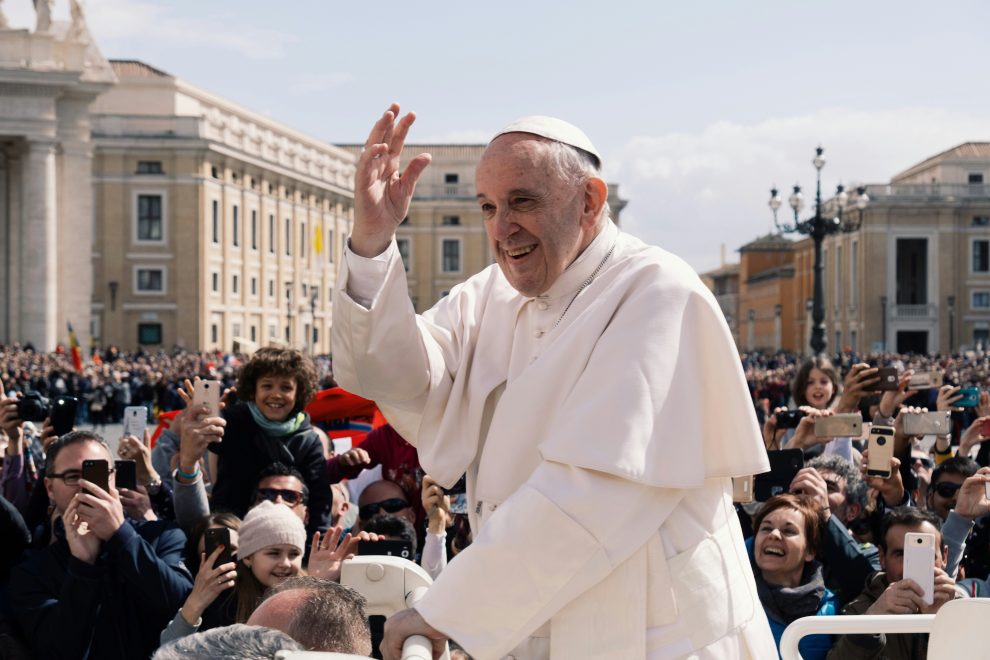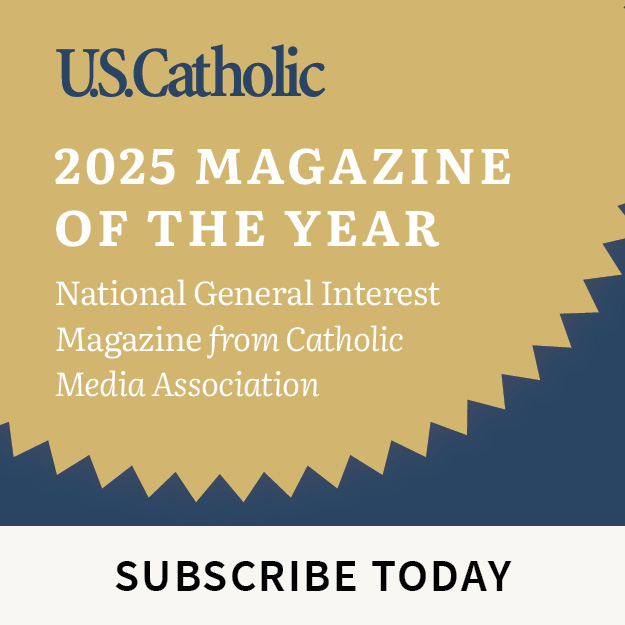On Monday April 21, 2025, at age 88, Pope Francis passed away. He had recently spent 38 days in the hospital for double pneumonia.
Elected to the papacy on March 13, 2013, Jorge Mario Bergoglio was the first prelate from the global South and the first Jesuit to lead the Catholic Church. He was also the first pope to choose the name “Francis.” In many respects, his name set the tone for his papacy.
Like St. Francis of Assisi, Pope Francis prized simplicity. When elected, the new pope eschewed the golden cross and scarlet shoes of his predecessors, keeping the humbler silver cross and black shoes he had worn as a bishop. As a residence, he opted for the Vatican guest house over the papal apartments. And to the papal limousine, Francis preferred a Ford Focus.
Pope Francis also shared his namesake’s special concern for the poor and marginalized. From washing the feet of young prisoners on Holy Thursday, to embracing a disfigured man in St. Peter’s square, to preaching on the shores of Lampedusa (a hub for migrant refugees), his first year in office was filled with public displays of mercy that “went viral.” Even social media, he showed, could be a vehicle for the gospel.
From Francis the saint, Francis the pope likewise took the title and inspiration for his landmark encyclical Laudato Si’ (On Care for our Common Home). The first document of papal social teaching centered on the environment, it laid out a vision of care for creation that Francis championed throughout his pontificate.
Above all, like his namesake, Pope Francis felt a calling to “repair” God’s church. Appalled by the corruption he saw within it, Francis insisted the church had to return to the fullness, the simplicity, and the authentic radicalism of Christ’s gospel. The reforming agenda that defined his papacy grew out of this conviction. Its ultimate outcome, however, remains to be seen.
Argentine by birth, Jesuit by calling
Who was Jorge Bergoglio? Born in 1936 in Buenos Aires, Argentina, he was a child of working-class Italian immigrants, whose Catholic identity straddled the Old World and the New. Though not initially drawn to a religious vocation, at 16 Bergoglio had a transformative encounter with Christ during confession that left him certain of his calling as a priest. While in seminary, he discerned a further vocation to the Society of Jesus and began a formation process that lasted 15 years (1958–1973).
Once ordained, Bergoglio rose rapidly through the ranks of his order, thanks to a combination of piety, intelligence, discipline, and leadership ability. At a mere 37, he was appointed provincial of Argentina, overseeing all the Jesuits in his native country. Six years later, when his term ended, Bergoglio became rector of the Colegio Maximo, the school where most Argentine Jesuits (including him) were trained. Though Jesuit vocations were in decline throughout Latin America, and elsewhere, under Bergoglio’s leadership they grew significantly in Argentina.
From reformer to exile
As a leader, Bergoglio sought not merely to grow the Jesuit order but to reform it. One of his priorities was to return the Jesuits to the rich, Christ-centered spirituality of their founder, St. Ignatius. Another was to root them more deeply among “the people,” in accord with the “theology of the people” that Bergoglio imbibed during these years.
The “theology of the people” (teología del pueblo) was a distinctively Argentine branch of liberation theology that emerged in the decade after Vatican II. Whereas other liberation theologians conceived history as a struggle between opposing social classes, Bergoglio and his Argentine colleagues envisioned it as a centuries-long process of “people-building.” Through this process, previously divided social groups gradually forged new relationships and cultural traditions to create new “peoples”: dynamically evolving communities that did not suppress their internal differences but progressively integrated them in a higher synthesis. The church’s role was to infuse the gospel into this process while ensuring that all members of society had the agency to participate in it. To play this role, however, the church had to immerse itself in the life of the masses—the working-class, the poor, and the marginalized—and accompany them in their daily joys and sorrows. While evangelizing the people, the church would also be evangelized by them.
Bergoglio’s attempts to create a Jesuit order informed by this theology won him many fervent disciples. Yet they also aroused opposition among more radical Jesuits who saw him as too conservative. So did Bergoglio’s choice to cooperate with the military dictatorship that ruled Argentina from 1976 to 1983—a pragmatic decision that allowed him to save many lives, but to his critics suggested complicity. By 1990, Bergoglio’s opponents had secured his dismissal from the Maximo and isolated him from any further leadership roles. Exiled within his own order, he would arrive at the papacy by a different path.
A new road to leadership
Bergoglio’s fortunes revived in 1992 when Cardinal Antonio Quarracino of Buenos Aires appointed him one of his auxiliary bishops. The Jesuit so impressed the cardinal that Quarracino soon promoted him to coadjutor. Consequently, when Quarracino died in 1998, it was Bergoglio who succeeded him first as archbishop and later, in 2001, as cardinal of Buenos Aires.
In retrospect, Bergoglio the cardinal prefigured Francis the pope. Living humbly, he spent the bulk of his time in poor barrios rather than the wealthy parishes favored by his predecessors. While redirecting diocesan resources to pastoral programs for the city’s most deprived areas, he also prioritized rooting out the corruption he found rampant within the diocese itself.
Beyond Argentina, meanwhile, Bergoglio’s appearances in Rome began to win him the respect of his fellow cardinals. When Pope John Paul II died in 2005, he emerged as Joseph Ratzinger’s primary contender to succeed him. Nonetheless, Bergoglio felt strongly that it was not his time. He urged his supporters to vote instead for Ratzinger, thereafter Pope Benedict XVI.
Though often contrasted, Benedict and Bergoglio in fact worked well together. Perhaps the greatest result of their collaboration was the Latin American bishops’ 2007 conference in Aparecida, Brazil. While Benedict presided over the proceedings, Bergoglio worked to build consensus among his fellow bishops around a shared vision for the Latin American church. That vision, enshrined in the conference’s final document, would set the agenda for his own papacy.
A pope of reform
When Bergoglio was elected pope in March 2013, it was with a reformer’s mandate. For over a decade, the global hierarchy had been struggling to respond to the clerical sex abuse crisis. More recently in 2012, the Vatileaks scandal had laid the corruption of the Roman curia bare for all to see. The church urgently needed to get its own house in order. And Bergoglio, his fellow bishops discerned, was the man for the job.
Once in office, Pope Francis wasted no time. In his first month, he created a new advisory body, the Council of Cardinals, to work directly with him on all key initiatives; this gave leaders from across the global church input at the highest level of governance. The following month, Francis and the council launched a new commission to oversee the cleanup of the Vatican’s finances. The ensuing process was bumpy, to say the least. Yet within several years, it yielded a more transparent, efficient, and accountable financial bureaucracy, overseen by a body of international lay professionals.
Meanwhile, in Evangelii Gaudium (The Joy of the Gospel), his first major teaching document, Francis outlined the larger vision driving his reforms. Echoing Aparecida, the pope stressed that the church did not merely have, but was, a mission: a perpetual outward movement to share the gospel with the world. Fulfilling its mission, however, would demand a conversion on the church’s part: a turn away from self-enclosure, clericalism, and “spiritual worldliness” toward the openness, humility, and all-inclusive love embodied by Christ. It would also require the participation, and leadership, of all the people of God, and the laity in particular.
Further reforms soon followed. In 2016, Francis and the council began the arduous task of reorganizing the Vatican curia, a process that came to fruition in 2022 with the promulgation of a new curial constitution, Praedicate Evangelium. Among its many innovations was the opening of key leadership positions to lay people and women, breaking the clerical monopoly on curial power.
By comparison, Francis’ response to the sexual abuse crisis got off to a rough start. When he defended a Chilean bishop credibly accused of protecting abusers in 2018, the pope aroused widespread outrage. Yet the experience appeared to move the pope toward a conversion of his own. After publicly asking for forgiveness from Chilean abuse victims, Francis went on to enact several key reforms to promote greater transparency in the reporting process and greater accountability for abusers and their protectors.
A synodal church?
Without doubt, Francis’ most ambitious reform was his attempt to create a more “synodal” church. While Pope Paul VI had established a Synod of Bishops just after Vatican II, for decades, it had been little more than an intermittent, and relatively powerless, advisory body; the pope and the curia continued to set the church’s agenda. For Francis, by contrast, “synodality” represented a new way of being for the church as a whole. A missional church, Francis insisted, was one faithful enough to preserve the timeless gospel yet flexible enough to adapt its mode of presentation to changing times. Yet how was such adaptation to occur? Not from top-down papal fiat, Francis believed, but from the bottom up, through an emergent process of listening, dialogue, and consensus-building across the whole people of God, guided by the Holy Spirit. Such was synodality.
Initially, Francis sought to move the church towards greater synodality by convening bishops’ synods on particular issues: the two-part Synod on the Family in 2014 and 2015, the Synod on Youth in 2018, and the Amazon Synod in 2019. With the launch of the three-year Synod on Synodality in 2021, however, the question of how to create a more synodal church was itself made the central matter for discernment. What will come of it? Though the Synod formally concluded in October 2024, it is still too soon to tell.
An open-ended legacy
Francis leaves behind an open-ended legacy, and a contested one. Were his reforms adequate to meet the challenges facing the church? On this question, disagreement persists. While some claim Francis went too far, other maintain he did not go nearly far enough.
In the United States, especially, the reception of Francis’s papacy has been highly polarized. Conservative Catholics faulted the pope for attempting to change doctrines that simply could not be changed. Conversely, liberal Catholics criticized him precisely for not changing the church’s core teaching on vexed questions of family, gender, and sexuality. Indeed, to the frustration of both groups, Francis consistently opted for a middle course. Rather than revising church teaching directly, he sought instead to create collective process for the entire church to discern whether, and how, to change.
Hence the singular importance of the Synod on Synodality, the largest consultative process in human history—and Francis’s greatest gamble. If the Synod built sufficient support for synodality across the global and increasingly diverse Catholic Church, as Francis hoped it would, it could establish a new template for how the church conducts itself at every level. Were this to happen, the Synod would prove to be as great a turning point for Catholicism as Vatican II. Conversely, if the Synod failed to build broad enough consensus around synodality, it may prove to be an abortive experiment that dies with Francis’s papacy, leaving many changes incomplete and many hopes disappointed. Either way, much will depend on Francis’ successor, and whether he chooses to build on Francis’ reforms, or reverse them.
Regardless, what cannot be denied is that this visionary pope sought to chart a new course for the Catholic Church and invited us all to play a role in it. What role shall we play? As Francis’ papacy ends, his question to each of us endures.
Photo by Ashwin Vaswani on Unsplash













Add comment